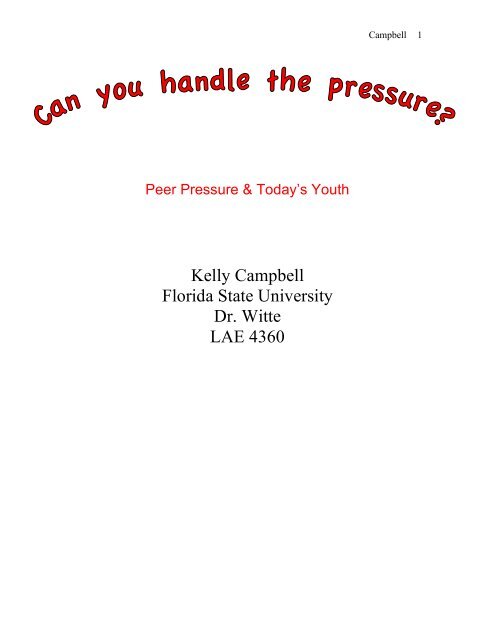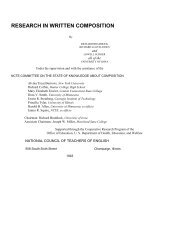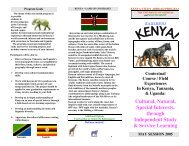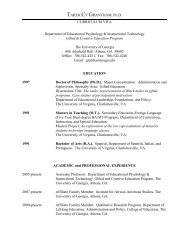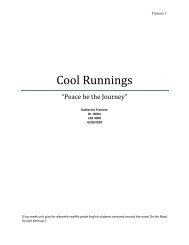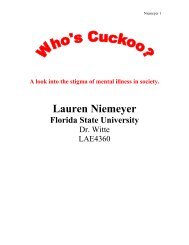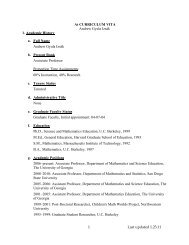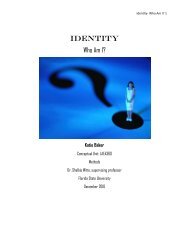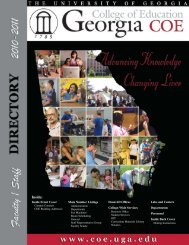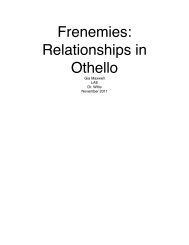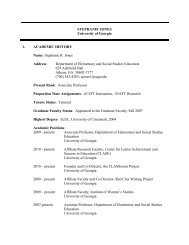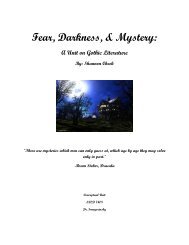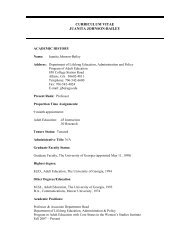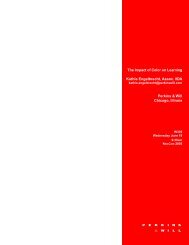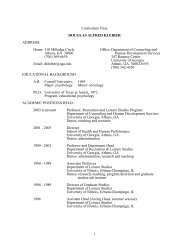Peer Pressure & Today's Youth by Kelly Campbell - College of ...
Peer Pressure & Today's Youth by Kelly Campbell - College of ...
Peer Pressure & Today's Youth by Kelly Campbell - College of ...
Create successful ePaper yourself
Turn your PDF publications into a flip-book with our unique Google optimized e-Paper software.
<strong>Peer</strong> <strong>Pressure</strong> & Today’s <strong>Youth</strong><br />
<strong>Kelly</strong> <strong>Campbell</strong><br />
Florida State University<br />
Dr. Witte<br />
LAE 4360<br />
<strong>Campbell</strong> 1
Table Of Contents<br />
<strong>Campbell</strong> 2<br />
Rationale………………………………………………………………………………3<br />
Goals & Objectives……………………………………………………………………8<br />
Sunshine State Standards………………………………………………………………9<br />
Materials……………………………………………………………………………….14<br />
Daily Classes…………………………………………………………………………..15<br />
Appendix A…………………………………………………………………………….23<br />
Appendix B…………………………………………………………………………….25<br />
Appendix C…………………………………………………………………………….26<br />
Appendix D…………………………………………………………………………….27<br />
Appendix E…………………………………………………………………………….29<br />
Appendix F…………………………………………………………………………….30<br />
Appendix G…………………………………………………………………………….38<br />
Appendix H…………………………………………………………………………….39<br />
Appendix I……………………………………………………………………………..40<br />
Appendix J……………………………………………………………………………..41<br />
Appendix K…………………………………………………………………………….42<br />
Appendix L……………………………………………………………………………..43<br />
Appendix M……………………………………………………………………………..46<br />
Appendix N: Pre & Post Test…………………………………………………………...48<br />
Appendix O: Diagnostic Pretest Analysis………………………………………………52<br />
Appendix P: Mini-Lessons………………………………………………………………53<br />
Appendix Q: Pre/Post Gains Analysis…………………………………………………..57<br />
Appendix R: Field Experience Interpretive Essay………………………………………50<br />
Bibliography…………………………………………………………………………….61
Rationale:<br />
<strong>Campbell</strong> 3<br />
The theme <strong>of</strong> this unit is peer pressure. The unit is designed to be taught to eighth<br />
grade students preferably near the end <strong>of</strong> the school year. The unit is designed in such a<br />
way because eighth graders will being going into high school the next year where peer<br />
pressure will likely reach a whole new level <strong>of</strong> intensity. <strong>Peer</strong> pressure is inevitable in<br />
any school setting, and reading and discussing issues related to peer pressure can help<br />
students cope, relate, and understand. Young adult novel “plots can shatter stereotypical<br />
ideas and portrayals <strong>of</strong>…peer pressure” (Beers, 72).<br />
The essential questions for this unit are: “What kind <strong>of</strong> peer pressure have you<br />
experienced?,” “Is peer pressure ever a good thing?,” and “How was peer pressure
portrayed in our texts?.” These questions will start the unit <strong>of</strong>f <strong>by</strong> getting students<br />
<strong>Campbell</strong> 4<br />
interested in the theme <strong>of</strong> peer pressure and thinking about its effects. By asking these<br />
questions again at the end <strong>of</strong> the unit, the students will be able to judge and discuss how<br />
the texts and activities from the unit may have changed their answers or understanding <strong>of</strong><br />
the theme <strong>of</strong> peer pressure as a whole.<br />
The main text <strong>of</strong> this unit is Speak <strong>by</strong> Laurie Halse Anderson. The young adult<br />
novel is told from the main character, Melinda’s, perspective. She is raped at a party in<br />
the summer before ninth grade, and she calls the cops. This incident makes her an outcast<br />
at school. She cannot fit into any clique and cannot manage the pressure she feels at<br />
school and at home, so she resorts to isolation. Melinda deals with issues <strong>of</strong> peer<br />
pressure, finding friends, fitting in, and telling her story. This book is a powerful first<br />
person portrayal <strong>of</strong> what peer pressure can do to a student.<br />
I have chosen to have the teacher <strong>of</strong> this unit read the majority <strong>of</strong> Speak in class. I<br />
have done so because I want students to actually read and enjoy the novel. I want them to<br />
be able to experience it and discuss it with their peers in a safe classroom community.<br />
This is valuable to their “learning, resolving issues [and] investigating complexities”<br />
(Beers, 45). I believe that students should enjoy reading, and <strong>of</strong>ten when too much <strong>of</strong> it is<br />
issued as homework it is portrayed solely as a mandatory assignment rather than as an<br />
experience to relate to and enjoy (Witte).<br />
The students are asked to write hallways logs and find and discuss articles that<br />
relate to peer pressure. The hallway logs ask them to record at least ten conversations or<br />
situations in which they overhear any form <strong>of</strong> peer pressure taking place. These logs will<br />
help them see that peer pressure surrounds them every day in their social climates.
<strong>Campbell</strong> 5<br />
Similarly, finding and discussing articles about peer pressure and the real effects it has on<br />
individuals and society will help them see what a powerful and dangerous tool peer<br />
pressure can be. Both assignments will help them see how easy it is to give into peer<br />
pressure and how <strong>of</strong>ten it happens.<br />
The students are asked to look at the theme <strong>of</strong> peer pressure in a variety <strong>of</strong><br />
texts including the short story “The Fan Club” <strong>by</strong> Rona Maynard (Appendix F), the<br />
movie Mean Girls (Waters), the movie Stand <strong>by</strong> Me (Reiner), and the song “Fifteen” <strong>by</strong><br />
Taylor Swift (Appendix M). This wide variety <strong>of</strong> texts, along with the articles, will help<br />
the students grasp a more well-rounded understanding <strong>of</strong> peer pressure and how it affects<br />
different people and social groups. They will be asked to relate almost all <strong>of</strong> these texts<br />
back to Speak, which will help them to make connections and recognize a theme across a<br />
variety <strong>of</strong> texts.<br />
The students will be given a number <strong>of</strong> writing assignments throughout the unit.<br />
Almost all <strong>of</strong> them are informally assessed and are given for the purpose <strong>of</strong> critical<br />
thinking, creativity, and making connections. The students will be asked to write about<br />
different forms <strong>of</strong> peer pressure, lies they tell you in middle school, the idea <strong>of</strong> perfection,<br />
and teenage life. These writing assignments are assigned for the purpose <strong>of</strong> getting<br />
students thinking introspectively about the effects <strong>of</strong> peer pressure as well as to help them<br />
make connections between their own lives and the characters in the texts they read.<br />
Twice in the unit the students are asked to make predictions about Speak. This<br />
will help the teacher gauge if the students are really understanding the events <strong>of</strong> the text.<br />
It will also help the students to think critically about what has happened in the novel and<br />
use that information to make intellectual predictions. Their predictions will be discussed
<strong>Campbell</strong> 6<br />
at the end <strong>of</strong> the novel so that they can see how they were right and wrong and how they<br />
may choose to predict differently or similarly in the future. They are also asked to write a<br />
book review at the end <strong>of</strong> the novel which is designed to help them form and defend<br />
opinions about literature.<br />
One task given to the students in the unit is to create a skit about an assigned form<br />
<strong>of</strong> peer pressure. This assignment allows them to work collaboratively toward a common<br />
goal. It will also help them to think more deeply about specific types <strong>of</strong> peer pressure.<br />
When they perform their skits they will be taking on the responsibility <strong>of</strong> showing the<br />
class either the effects <strong>of</strong> peer pressure or tools for overcoming it. Whichever way they<br />
choose to take their skit, they will be obligated to think pr<strong>of</strong>oundly about what peer<br />
pressure can do.<br />
About nine days and twenty nights (including weekends) <strong>of</strong> this unit are dedicated<br />
to literature circles. The students are given five choices <strong>of</strong> young adult novels that deal<br />
with the theme <strong>of</strong> peer pressure and form literature circle groups based on those choices.<br />
Each group will be given the responsibility <strong>of</strong> creating their own reading timeline- which<br />
means they will have to decide together how much they read in class and how many<br />
pages they read each night for homework. The purpose <strong>of</strong> this is to help the students learn<br />
to take responsibility for themselves and their time management. Each group will meet<br />
seven times during class. During these times they can read and discuss the text. They will<br />
also be given the task <strong>of</strong> making a book talk with a coordinating poster (Appendix J) that<br />
summarizes their novel and compares it to Speak in reference to the peer pressure theme<br />
<strong>of</strong> the unit. They will have to present their book talks as a group to the class. These tasks
will help the students to take responsibility, work cooperatively, manage their time<br />
effectively, think critically, and make crucial connections to another text.<br />
<strong>Campbell</strong> 7<br />
The culminating assessment for this unit is a choice between four performance<br />
assessments (Appendix L). The students can choose between making a soundtrack,<br />
making a commercial, making a poster, or making character Facebook pages. Each<br />
assessment will require them to relate their performance and creativity to both Speak and<br />
the young adult novel they read in their literature circles regarding the theme <strong>of</strong> peer<br />
pressure. By giving them choices for their culminating assessment, I believe that I am<br />
allowing them to show their knowledge and understanding <strong>of</strong> the texts and the peer<br />
pressure theme in a way that both interests them and appeals to their way <strong>of</strong> learning.<br />
Each assessment, I believe, effectively measures students’ learning from the unit while<br />
allowing them to be successful if they so choose.<br />
This unit is an important one because peer pressure is more alive and affective<br />
now than ever. Every student will deal with it- likely on a daily basis, and <strong>by</strong> reading<br />
about it, discussing it, and writing about it students will be able to make connections to<br />
each other and to the characters they read about. These connections are crucial for<br />
personal growth and development.
Goals and Objectives:<br />
1. Students will explore the reality and the effects <strong>of</strong> peer pressure.<br />
• SWBAT document situations <strong>of</strong> peer pressure in their social environments.<br />
• SWBAT research an article that deals with peer pressure.<br />
• SWBAT discuss the articles that deal with peer pressure.<br />
• SWBAT create a skit about a peer pressure-related topic.<br />
• SWBAT perform a skit about a peer pressure-related topic.<br />
• SWBAT discuss the realities <strong>of</strong> peer pressure.<br />
• SWBAT write about peer pressure in their lives.<br />
2. Students will form their own opinions about texts related to peer pressure.<br />
• SWBAT discuss a variety <strong>of</strong> texts related to peer pressure.<br />
• SWBAT make predictions about upcoming events in texts related to peer<br />
pressure.<br />
• SWBAT free write about peer pressure.<br />
• SWBAT write a book review for Speak.<br />
• SWBAT decide how texts affect their feelings toward peer pressure.<br />
3. Students will work cooperatively towards a common goal.<br />
• SWBAT work in a group to create peer pressure skits.<br />
• SWBAT perform peer pressure skits with a group.<br />
• SWBAT form a reading plan with a literature circle group.<br />
• SWBAT write a book talk with a literature circle group.<br />
<strong>Campbell</strong> 8
• SWBAT make book talk poster with a literature circle group.<br />
• SWBAT present a book talk with a literature circle group.<br />
<strong>Campbell</strong> 9<br />
4. Students will express an understanding <strong>of</strong> the peer pressure theme in relation to a<br />
variety <strong>of</strong> texts.<br />
• SWBAT answer questions about “The Fan Club” <strong>by</strong> Rena Maynard.<br />
• SWBAT compare and contrast texts in reference to the peer pressure theme.<br />
• SWBAT create a culminating assessment project that displays their understanding<br />
<strong>of</strong> the peer pressure theme in relation to Speak and the young adult novel they<br />
read in their literature circles.<br />
• SWBAT present a culminating assessment project that displays their<br />
understanding <strong>of</strong> the peer pressure theme in relation to Speak and the young adult<br />
novel they read in their literature circles.<br />
Benchmark<br />
Number<br />
LA.8.1.5.1<br />
Sunshine State Standards<br />
Descriptor<br />
The student will adjust reading rate based on purpose, text difficulty, form,<br />
and style.<br />
LA.8.1.6.1 The student will use new vocabulary that is introduced and taught directly;<br />
LA.8.1.6.2<br />
The student will listen to, read, and discuss familiar and conceptually<br />
challenging text;<br />
LA.8.1.6.3<br />
The student will use context clues to determine meanings <strong>of</strong> unfamiliar<br />
words;<br />
LA.8.1.6.4 The student will categorize key vocabulary and identify salient features;<br />
LA.8.1.6.5 The student will relate new vocabulary to familiar words;<br />
LA.8.1.6.6<br />
The student will distinguish denotative and connotative meanings <strong>of</strong><br />
words;<br />
LA.8.1.6.8<br />
The student will identify advanced word/phrase relationships and their<br />
meanings;<br />
LA.8.1.6.9<br />
The student will determine the correct meaning <strong>of</strong> words with multiple<br />
meanings in context;<br />
The student will determine meanings <strong>of</strong> words, pronunciation, parts <strong>of</strong><br />
LA.8.1.6.10 speech, etymologies, and alternate word choices <strong>by</strong> using a dictionary,<br />
thesaurus, and digital tools; and<br />
LA.8.1.7.1 The student will use background knowledge <strong>of</strong> subject and related content
<strong>Campbell</strong> 10<br />
areas, prereading strategies, graphic representations, and knowledge <strong>of</strong> text<br />
structure to make and confirm complex predictions <strong>of</strong> content, purpose,<br />
and organization <strong>of</strong> a reading selection;<br />
The student will analyze the authors purpose and/or perspective in a<br />
LA.8.1.7.2<br />
variety <strong>of</strong> texts and understand how they affect meaning;<br />
The student will determine the main idea or essential message in grade-<br />
LA.8.1.7.3 level or higher texts through inferring, paraphrasing, summarizing, and<br />
identifying relevant details;<br />
LA.8.1.7.4 The student will identify cause-and-effect relationships in text;<br />
The student will analyze a variety <strong>of</strong> text structures (e.g.,<br />
comparison/contrast, cause/effect, chronological order, argument/support,<br />
LA.8.1.7.5<br />
lists) and text features (main headings with subheadings) and explain their<br />
impact on meaning in text;<br />
The student will analyze and evaluate similar themes or topics <strong>by</strong> different<br />
LA.8.1.7.6<br />
authors across a variety <strong>of</strong> fiction and nonfiction selections;<br />
The student will compare and contrast elements in multiple texts (e.g.,<br />
LA.8.1.7.7<br />
setting, characters, problems); and<br />
The student will use strategies to repair comprehension <strong>of</strong> gradeappropriate<br />
text when self-monitoring indicates confusion, including but<br />
LA.8.1.7.8 not limited to rereading, checking context clues, predicting, note-making,<br />
summarizing, using graphic and semantic organizers, questioning, and<br />
clarifying <strong>by</strong> checking other sources.<br />
The student will identify, analyze, and compare the characteristics <strong>of</strong><br />
LA.8.2.1.1 various genres (e.g., poetry, fiction, short story, dramatic literature) as<br />
forms chosen <strong>by</strong> an author to accomplish a purpose;<br />
The student will locate and analyze elements <strong>of</strong> characterization, setting,<br />
LA.8.2.1.2 and plot, including rising action, conflict, resolution, theme, and other<br />
literary elements as appropriate in a variety <strong>of</strong> fiction;<br />
The student will locate various literary devices (e.g., sound, meter,<br />
LA.8.2.1.3 figurative and descriptive language), graphics, and structure and analyze<br />
how they contribute to mood and meaning in poetry;<br />
The student will identify and analyze universal themes and symbols across<br />
LA.8.2.1.4<br />
genres and historical periods, and explain their significance;<br />
The student will develop an interpretation <strong>of</strong> a selection and support<br />
LA.8.2.1.5<br />
through sustained use <strong>of</strong> examples and contextual evidence;<br />
The student will compare literary texts that express a universal theme,<br />
LA.8.2.1.6 providing textual evidence (e.g., examples, details, quotations) as support<br />
for the identified theme;<br />
The student will locate and analyze an author's use <strong>of</strong> allusions and<br />
descriptive, idiomatic, and figurative language in a variety <strong>of</strong> literary text,<br />
LA.8.2.1.7<br />
identifying how word choice is used to appeal to the reader's senses and<br />
emotions, providing evidence from text to support the analysis;<br />
The student will use interest and recommendation <strong>of</strong> others to select a<br />
LA.8.2.1.10 balance <strong>of</strong> age and ability appropriate fiction materials to read (e.g.,<br />
novels, historical fiction, mythology, poetry) to expand the core foundation
<strong>Campbell</strong> 11<br />
<strong>of</strong> knowledge necessary to function as a fully literate member <strong>of</strong> a shared<br />
culture.<br />
The student will locate, use, and analyze specific information from<br />
LA.8.2.2.1 organizational text features (e.g., table <strong>of</strong> contents, headings, captions, bold<br />
print, italics, glossaries, indices, key/guide words);<br />
The student will synthesize and use information from the text to state the<br />
LA.8.2.2.2<br />
main idea or provide relevant details;<br />
The student will organize information to show understanding or<br />
relationships among facts, ideas, and events (e.g., representing key points<br />
LA.8.2.2.3<br />
within text through charting, mapping, paraphrasing, summarizing, or<br />
comparing/contrasting);<br />
The student will identify and analyze the characteristics <strong>of</strong> a variety <strong>of</strong><br />
types <strong>of</strong> text (e.g., reference works, reports, technical manuals,<br />
LA.8.2.2.4<br />
newspapers, magazines, biographies, periodicals, procedures, instructions,<br />
practical/functional texts); and<br />
The student will use interest and recommendation <strong>of</strong> others to select a<br />
variety <strong>of</strong> age and ability appropriate nonfiction materials (e.g.,<br />
LA.8.2.2.5 biographies and topical areas, such as science, music, art, history, sports,<br />
current events) to expand the core knowledge necessary to connect topics<br />
and function as a fully literate member <strong>of</strong> a shared culture.<br />
The student will prewrite <strong>by</strong> generating ideas from multiple sources (e.g.,<br />
prior knowledge, discussion with others, writers notebook, research<br />
LA.8.3.1.1<br />
materials, or other reliable sources) based upon teacher-directed topics and<br />
personal interests;<br />
The student will draft writing <strong>by</strong> developing ideas from the prewriting plan<br />
LA.8.3.2.1 using primary and secondary sources appropriate to the purpose and<br />
audience;<br />
The student will draft writing <strong>by</strong> establishing a logical organizational<br />
LA.8.3.2.2 pattern with supporting details that are substantial, specific, and relevant;<br />
and<br />
The student will draft writing <strong>by</strong> analyzing language techniques <strong>of</strong><br />
pr<strong>of</strong>essional authors (rhythm, varied sentence structure) to develop a<br />
LA.8.3.2.3<br />
personal style, demonstrating a command <strong>of</strong> language with freshness <strong>of</strong><br />
expression.<br />
The student will revise <strong>by</strong> evaluating the draft for development <strong>of</strong> ideas<br />
LA.8.3.3.1 and content, logical organization, voice, point <strong>of</strong> view, word choice, and<br />
sentence variation;<br />
The student will revise <strong>by</strong> creating clarity and logic <strong>by</strong> maintaining central<br />
LA.8.3.3.2<br />
theme, idea, or unifying point and developing relationships among ideas;<br />
The student will revise <strong>by</strong> creating precision and interest <strong>by</strong> elaborating<br />
ideas through supporting details (e.g., facts, statistics, expert opinions,<br />
LA.8.3.3.3 anecdotes), a variety <strong>of</strong> sentence structures, creative language devices, and<br />
modifying word choices using resources and reference materials (e.g.,<br />
dictionary, thesaurus); and<br />
LA.8.3.3.4 The student will revise <strong>by</strong> applying appropriate tools or strategies to
<strong>Campbell</strong> 12<br />
evaluate and refine the draft (e.g., peer review, checklists, rubrics).<br />
The student will edit for correct use <strong>of</strong> spelling, using spelling rules,<br />
orthographic patterns, generalizations, knowledge <strong>of</strong> root words, prefixes,<br />
LA.8.3.4.1<br />
suffixes, and knowledge <strong>of</strong> Greek and Latin root words and using a<br />
dictionary, thesaurus, or other resources as necessary;<br />
The student will edit for correct use <strong>of</strong> capitalization, including names <strong>of</strong><br />
LA.8.3.4.2 academic courses (e.g., Algebra I) and proper adjectives (e.g., German<br />
shepherd, Italian restaurant);<br />
The student will edit for correct use <strong>of</strong> punctuation, including commas,<br />
LA.8.3.4.3<br />
colons, semicolons, quotation marks, and apostrophes;<br />
The student will edit for correct use <strong>of</strong> the eight parts <strong>of</strong> speech (noun,<br />
LA.8.3.4.4 pronoun, verb, adverb, adjective, conjunction, preposition, interjection),<br />
regular and irregular verbs, and pronoun agreement; and<br />
The student will edit for correct use <strong>of</strong> subject/verb agreement,<br />
LA.8.3.4.5<br />
noun/pronoun agreement.<br />
The student will prepare writing using technology in a format appropriate<br />
LA.8.3.5.1<br />
to audience and purpose (e.g., manuscript, multimedia);<br />
The student will use elements <strong>of</strong> spacing and design for graphics (e.g.,<br />
LA.8.3.5.2 tables, drawings, charts, graphs) when applicable to enhance the<br />
appearance <strong>of</strong> the document; and<br />
LA.8.3.5.3 The student will share the writing with the intended audience.<br />
The student will write in a variety <strong>of</strong> informational/expository forms (e.g.,<br />
LA.8.4.2.1 summaries, procedures, instructions, experiments, rubrics, how-to manuals,<br />
assembly instructions);<br />
The student will record information (e.g., observations, notes, lists, charts,<br />
LA.8.4.2.2 legends) related to a topic, including visual aids to organize and record<br />
information, as appropriate, and attribute sources <strong>of</strong> information;<br />
The student will write detailed directions to unfamiliar locations using<br />
LA.8.4.2.5 cardinal and ordinal directions, landmarks, streets, and distances, and<br />
create an accompanying map.<br />
The student will include persuasive techniques (e.g., word choice,<br />
repetition, emotional appeal, hyperbole, appeal to authority, celebrity<br />
LA.8.4.3.2<br />
endorsement, rhetorical question, irony, symbols, glittering generalities,<br />
card stacking).<br />
LA.8.5.1.1 The student will use fluent and legible handwriting skills.<br />
The student will demonstrate effective listening skills and behaviors for a<br />
LA.8.5.2.1 variety <strong>of</strong> purposes, and demonstrate understanding <strong>by</strong> paraphrasing and/or<br />
summarizing;<br />
The student will use effective listening and speaking strategies for informal<br />
and formal discussions, connecting to and building on the ideas <strong>of</strong> a<br />
LA.8.5.2.2<br />
previous speaker and respecting the viewpoints <strong>of</strong> others when identifying<br />
bias or faulty logic;<br />
The student will select and use a variety <strong>of</strong> creative oral language<br />
LA.8.5.2.3 techniques for clarity and effect (e.g., connotation, denotation, hyperbole,<br />
understatement);
LA.8.5.2.4<br />
LA.8.5.2.5<br />
LA.8.6.1.1<br />
LA.8.6.2.3<br />
LA.8.6.2.4<br />
LA.8.6.3.1<br />
LA.8.6.3.2<br />
LA.8.6.3.3<br />
LA.8.6.4.1<br />
LA.8.6.4.2<br />
<strong>Campbell</strong> 13<br />
The student will research, organize, and effectively deliver speeches to<br />
entertain, inform, and persuade;<br />
The student will demonstrate language choices, body language, eye<br />
contact, gestures, and appropriate use <strong>of</strong> graphics and available technology.<br />
The student will explain how text features (e.g., charts, maps, diagrams,<br />
sub-headings, captions, illustrations, graphs) aid the reader's<br />
understanding;<br />
The student will write an informational report that includes a focused topic,<br />
appropriate facts and relevant details, a logical sequence, a concluding<br />
statement, and a list <strong>of</strong> sources used; and<br />
The student will understand the importance <strong>of</strong> legal and ethical practices,<br />
including laws regarding libel, slander, copyright, and plagiarism in the use<br />
<strong>of</strong> mass media and digital sources, know the associated consequences, and<br />
comply with the law.<br />
The student will analyze ways that production elements (e.g., graphics,<br />
color, motion, sound, digital technology) affect communication across the<br />
media;<br />
The student will demonstrate the ability to select and ethically use print<br />
and nonprint media appropriate for the purpose, occasion, and audience to<br />
develop into a formal presentation; and<br />
The student will distinguish between propaganda and ethical reasoning<br />
strategies in print and nonprint media.<br />
The student will use appropriate available technologies to enhance<br />
communication and achieve a purpose (e.g., video, digital technology); and<br />
The student will evaluate and apply digital tools (e.g., word, processing,<br />
multimedia authoring, web tools, graphic organizers) to publications and<br />
presentations.
Materials<br />
• Speak<br />
• Poster boards<br />
• Construction Paper<br />
• Markers<br />
• Scissors<br />
• “The Fan Club” <strong>by</strong> Rona Maynard<br />
• Notebooks<br />
• Pencils<br />
• Pens<br />
• Mean Girls<br />
• Stand <strong>by</strong> My<br />
• “Fifteen” <strong>by</strong> Taylor Swift<br />
• The Berenstein Bears and the Double Dare<br />
• The Skin I’m In<br />
• Thirteen Reasons Why<br />
• The Truth About Truman School<br />
<strong>Campbell</strong> 14
• Black and White<br />
• Touching Spirit Bear<br />
Daily Classes<br />
50 Minute Classes<br />
Day 1:<br />
3 minutes: Attendance and housekeeping.<br />
<strong>Campbell</strong> 15<br />
12 minutes: Teacher reads The Berenstain Bears and the Double Dare to the students,<br />
and they discuss the story.<br />
15 minutes: Students write their answers to the essential questions: “What kind <strong>of</strong> peer<br />
pressure have you experienced?” “Is peer pressure ever a good thing?” “How was peer<br />
pressure portrayed in The Berenstain Bears and the Double Dare?”<br />
20 minutes: Students discuss their answers to the essential questions, and as they do so,<br />
the teacher paraphrases the answers on the board. (Teacher will record answers to be<br />
reviewed again at the end <strong>of</strong> the unit.)<br />
Day 2:<br />
3 minutes: Attendance and housekeeping.<br />
12 minutes: Book talk (Appendix A)
20 minutes: Teacher reads first 10 pages <strong>of</strong> Speak to the class and they discuss.<br />
<strong>Campbell</strong> 16<br />
15 minutes: Students write their own “10 Lies They Tell You in School” list (Appendix<br />
B)<br />
HW: Students finish their lists if they did not do so in class.<br />
Day 3:<br />
3 minutes: Attendance and housekeeping.<br />
22 minutes: The teacher reads about ten pages <strong>of</strong> Speak to the class. As she reads, the<br />
students mark lines that have to do with peer pressure or that pose a question they would<br />
like to discuss with sticky notes.<br />
20 minutes: The class discusses what they marked with their sticky notes. Teacher helps<br />
facilitate discussion and answers questions that classmates cannot.<br />
5 minutes: Teacher explains hallway log assignment: Students are to write in a hallway<br />
log recording examples <strong>of</strong> peer pressure they hear around school and other social<br />
environments (Appendix C )<br />
HW: hallway logs<br />
Day 4:<br />
3 minutes: Attendance and housekeeping.<br />
22 minutes: The teacher reads about ten pages <strong>of</strong> Speak to the class. As she reads, the<br />
students mark lines that have to do with peer pressure or that pose a question they would<br />
like to discuss with sticky notes.<br />
25 minutes: The class discusses what they marked with their sticky notes. Teacher helps<br />
facilitate discussion and answers questions that classmates cannot.<br />
HW: hallway logs<br />
Day 5:<br />
3 minutes: Attendance and housekeeping<br />
22 minutes: The teacher reads about ten pages <strong>of</strong> Speak to the class. As she reads, the<br />
students mark lines that have to do with peer pressure or that pose a question they would<br />
like to discuss with sticky notes.<br />
15 minutes: The class discusses what they marked with their sticky notes. Teacher helps<br />
facilitate discussion and answers questions that classmates cannot.
<strong>Campbell</strong> 17<br />
5 minutes: The teacher reviews with the class what has happened so far in the novel.<br />
5 minutes: The students make predictions about what they think will happen later in the<br />
novel.<br />
HW: hallway logs and “Clans, Cliques, and Outsiders” worksheet (Appendix D )<br />
Day 6:<br />
3 minutes: Attendance and housekeeping<br />
12 minutes: Discuss “Clans, Cliques, and Outsiders” (Appendix D ) worksheet and turn it<br />
in<br />
20 minutes: The teacher reads about ten pages from Speak and facilitates a short<br />
discussion that follows.<br />
15 minutes: Students will choose 15 terms from the vocabulary list (Appendix E), and<br />
define and write a sentence using each.<br />
HW: hallway logs, finish vocabulary assignment if they did not do so in class.<br />
Day 7:<br />
3 minutes: Attendance and housekeeping.<br />
20 minutes: Read “The Fan Club” <strong>by</strong> Rona Maynard (Appendix F) as a class.<br />
10 minutes: Students answer questions on “The Fan Club” worksheet (Appedix G ) for a<br />
completion grade.<br />
17 minutes: Class discussion about the story, the answers to the questions on the<br />
worksheet, and how the story connects to Speak.<br />
HW: hallway logs<br />
Day 8:<br />
3 minutes: Attendance and housekeeping.<br />
22 minutes: Teacher reads about 10 pages <strong>of</strong> Speak and discusses the text with students.<br />
25 minutes: Students free write for a completion grade, answering the following prompt:<br />
“Later in the book, Mr. Freeman says, ‘Nothing is perfect. Flaws are interesting’ Do you<br />
agree or disagree? Why? How does this statement relate to our theme <strong>of</strong> peer pressure?”<br />
HW: hallways logs and find an article dealing with peer pressure to bring in
Day 9<br />
3 minutes: Attendance and housekeeping<br />
22 minutes: The teacher reads about 10 pages <strong>of</strong> Speak and discusses the text with<br />
students.<br />
<strong>Campbell</strong> 18<br />
25 minutes: The students present their articles and the class discusses them and the real<br />
effects <strong>of</strong> peer pressure.<br />
HW: finish hallway logs<br />
Day 10<br />
3 minutes: Attendance and housekeeping. Turn in hallway logs.<br />
22 minutes: The teacher reads about 10 pages <strong>of</strong> Speak and discusses the text with the<br />
students.<br />
25 minutes: Students get into pre-determined groups and choose a topic out <strong>of</strong> a bowl:<br />
“positive peer pressure,” “peer pressure to drink,” “peer pressure to steal,” “peer pressure<br />
to be popular,” “peer pressure to be in a certain group.” “peer pressure to do drugs,”<br />
“peer pressure to be perfect.” As a group, they will come up with a short skit displaying<br />
their form <strong>of</strong> peer pressure. The skit must either show the long-term affects <strong>of</strong> the peer<br />
pressure or show a way to overcome it.<br />
HW: read the next 10 pages <strong>of</strong> Speak using post-it strategy (marking the lines that deal<br />
with peer pressure and anything they would like to ask or discuss in class)<br />
Day 11:<br />
3 minutes: Attendance and housekeeping.<br />
5 minutes: Discussion about the ten pages they read over the weekend.<br />
12 minutes: Students get into their groups from the last class meeting and finish/practice<br />
their skits.<br />
25 minutes: Each group will perform their skit for the class, and the class will briefly<br />
discuss each topic following its related skit.<br />
5 minutes: The teacher gives the students a list <strong>of</strong> books: The Skin I’m in, Thirteen<br />
Reasons Why, The Truth About Truman School, Black and White, and Touching Spirit<br />
Bear and tells them that they will have to choose one to read with a group <strong>of</strong> classmates.<br />
HW: Look up the books on the list and decide which one you’d like to read.<br />
Day 12:
3 minutes: Attendance and housekeeping.<br />
<strong>Campbell</strong> 19<br />
22 minutes: The teacher reads about ten pages from Speak and discusses the text with the<br />
students.<br />
10 minutes: The teacher gives a quick summary <strong>of</strong> each YA novel on the list provided<br />
yesterday.<br />
15 minutes: The students decide which literature circles they would like to be in (teacher<br />
mediates to get groups close to even). After they are in their groups, they have to come<br />
up with a plan to finish the book and prepare a book talk <strong>by</strong> day 26: How much are they<br />
going to read each night? Will they spend any time reading in class?<br />
HW: start reading YA novel according to group’s plan.<br />
Day 13:<br />
3 minutes: Attendance and housekeeping.<br />
22 minutes: Teacher reads about ten pages from Speak and discusses the text with the<br />
students.<br />
25 minutes: Students pull prompts out <strong>of</strong> a hat that say “Speak up about _______”<br />
(Appendix H) and free write their responses for a completion grade.<br />
HW: read YA novel for literature circle<br />
Day 14:<br />
3 minutes: Attendance and housekeeping.<br />
22 minutes: The teacher will read about ten pages from Speak and discuss the text with<br />
the students.<br />
25 minutes: The students will get into their literature circles to read/discuss their texts.<br />
HW: read YA novel for literature circle<br />
Day 15:<br />
3 minutes: Attendance and housekeeping<br />
22 minutes: Teacher reads about 10 pages from Speak. (The class should now be around<br />
page 130- she has had multiple interactions with Andy and Mr. Freeman and has no<br />
friends and issues with her parents)<br />
25 minutes: Teacher facilitates discussion about what the students think about the book<br />
so far. They will discuss peer pressure and make predictions about the ending.
HW: read YA novel for literature circles<br />
Day 16:<br />
3 minutes: Attendance and housekeeping.<br />
<strong>Campbell</strong> 20<br />
47 minutes: The teacher will show scenes from the movie Mean Girls and students will<br />
take notes (Appendix I)<br />
HW: continue to read YA novels for literature circles and read the next 10 pages <strong>of</strong><br />
Speak using post-it strategy (marking the lines that deal with peer pressure and anything<br />
they would like to ask or discuss in class)<br />
Day 17:<br />
3 minutes: Attendance and housekeeping<br />
5 minutes: The teacher and students discuss the ten pages read for homework.<br />
20 minutes: The teacher reads about ten pages from Speak to the students and they<br />
discuss the text.<br />
22 minutes: The students meet with their literature circle groups and read/discuss their<br />
YA novel and make sure everyone is following their reading plan.<br />
HW: Continue reading YA novel for literature circle.<br />
Day 18:<br />
3 minutes: Attendance and housekeeping.<br />
47 minutes: The teacher will show clips from the movie Stand <strong>by</strong> Me, and the students<br />
will take notes as they watch (Appendix I)<br />
HW: continue to read YA novels for literature circles and read the next 10 pages <strong>of</strong> Speak<br />
using post-it strategy (marking the lines that deal with peer pressure and anything they<br />
would like to ask or discuss in class)<br />
Day 19:<br />
3 minutes: Attendance and housekeeping<br />
5 minutes: Discussion about the ten pages read for homework<br />
20 minutes: The teacher reads about ten pages from Speak to the class and they discuss<br />
the text<br />
22 minutes: The students meet with their literature circle groups to read/discuss their YA<br />
novels and their reading plans.
<strong>Campbell</strong> 21<br />
HW: students continue to follow their literature circle reading plans and read selection<br />
from YA novel<br />
Day 20:<br />
3 minutes: Attendance and housekeeping<br />
20 minutes: The teacher reads about ten pages from Speak to the class and they discuss<br />
the text.<br />
5 minutes: The students review the notes they made during “Mean Girls” and “Stand <strong>by</strong><br />
Me”<br />
22 minutes: The teacher and students discuss similarities they saw between the movies<br />
and Speak using the movie notes. Students turn both sets <strong>of</strong> notes in for a completion<br />
grade.<br />
HW: continue reading YA novels for literature circles<br />
Day 21:<br />
3 minutes: Attendance and housekeeping<br />
22 minutes: The teacher reads about ten pages from Speak and discusses the text with the<br />
students.<br />
25 minutes: The students meet with their literature circles to read/discuss their YA novels<br />
and start to think <strong>of</strong> ideas for the book talk they will give for their novel (Appendix J)<br />
HW: continue reading YA novels for literature circles<br />
Day 22:<br />
3 minutes: Attendance and housekeeping<br />
22 minutes: The teacher reads the ending <strong>of</strong> Speak to the students.<br />
25 minutes: The teacher and students discuss the ending <strong>of</strong> the book, their opinions about<br />
the book as a whole, how the book related to the peer pressure them, and talk about the<br />
predictions made on day 5 and day 15<br />
HW: write a book review for Speak (Appendix K) and continue reads YA novels for<br />
literature circles.<br />
Day 23:<br />
3 minutes: Attendance and housekeeping; turn in book reviews<br />
25 minutes: The teacher goes over all the options for the unit’s performance assessment<br />
(Appendix L)
<strong>Campbell</strong> 22<br />
22 minutes: The students choose a performance assessment, take a description/rubric for<br />
the performance assessment <strong>of</strong> their choice (Appendix L), and begin brainstorming, and<br />
ask questions.<br />
HW: continue reading YA novels for literature circles and work on performance<br />
assessment<br />
Day 24:<br />
3 minutes: Attendance and housekeeping<br />
47 minutes: Students meet with their literature circle groups, read/discuss their YA<br />
novels, and begin working on their book talk and poster (Appendix J)<br />
HW: FINISH reading YA novels if they have not yet done so and work on performance<br />
assessments<br />
Day 25:<br />
3 minutes: Attendance and housekeeping<br />
47 minutes: Students can use this time to either finish their book talks and posters with<br />
their literature circle groups or work on their performance assessment.<br />
HW: work on performance assessment<br />
Day 26:<br />
3 minutes: Attendance and housekeeping<br />
47 minutes: Literature circle groups give book talks and present posters (Appendix J)<br />
HW: work on performance assessment<br />
Day 27:<br />
3 minutes: Attendance and housekeeping.<br />
30 minutes: Students listen to the song “Fifteen” <strong>by</strong> Taylor Swift (Appendix M) and free<br />
write for a completion grade about how the song could relate to the situations <strong>of</strong> any <strong>of</strong><br />
the characters they’ve read about.<br />
17 minutes: Students work on performance assessments that are due tomorrow and ask<br />
any final questions they may have<br />
HW: Finish performance assessments<br />
Day 28:<br />
3 minutes: Attendance and housekeeping
47 minutes: Students present performance assessments (Appendix L)<br />
HW: none<br />
Day 29:<br />
3 minutes: Attendance and housekeeping<br />
47 minutes: Students present performance assessments (Appendix L)<br />
HW: none<br />
Day 30:<br />
3 minutes: Attendance and housekeeping<br />
<strong>Campbell</strong> 23<br />
47 minutes: The students revisit the essential questions from day 1, discussing how peer<br />
pressure was portrayed in all the texts they experienced in the unit, and compare their<br />
answers. They discuss how Speak and the other texts influenced any change in answers.<br />
HW: none<br />
APPENDIX A<br />
Speak Book Talk<br />
By: Bonnie Phinney<br />
http://nancykeane.com/booktalks/anderson_speak.htm<br />
I am an outcast.<br />
My first day <strong>of</strong> high school and I can see, as we are herded into the<br />
auditorium for orientation, that I don’t fit in. Everyone else falls into a<br />
clan – you know, a clique; THE JOCKS, THE CHEERLEADERS,<br />
FUTURE FASCISTS OF AMERICA, GOTHS, …well, you get the idea.<br />
Me? I am clanless…I have entered high school with the wrong hair, the<br />
wrong clothes, and definitely the wrong attitude. No one will speak to<br />
me.<br />
I am an outcast.
<strong>Campbell</strong> 24<br />
The orientation begins with “the rules” – All lies! #1. We are here to<br />
help you! #2. You will have enough time to get to your classes between<br />
bells. #3. The dress code will be enforced. #4. No smoking is allowed<br />
on school grounds. #5. Our football team will win the championship.<br />
#6. We expect more <strong>of</strong> you here. #7. Guidance counselors are always<br />
available to listen. #8 Your schedule was created with your needs in<br />
mind. #9. Your locker combination is private. #10. These will be the<br />
years you will look back on most fondly.<br />
Yeah, right! Fondly. NOT.<br />
I didn’t want high school to start out this way – it just sort <strong>of</strong><br />
happened. I’m not used to failing classes. I don’t skip school. I talk. I<br />
have friends.<br />
Not any more.<br />
It all started at that end-<strong>of</strong>-the-summer party. Big deal, that party.<br />
Rachel and I were pretty excited about going to a high school party.<br />
Now, they all blame me – they blame me for calling the cops and closing<br />
down the party. Even Rachel hates me.<br />
I am an outcast.<br />
No one knows the truth about that night. No one CARES to know the<br />
truth. I don’t know the truth - can’t face the truth, anyway.<br />
So, I get a brilliant idea … if they won’t talk to me, then I won’t talk to<br />
them! I’ll just retreat. Yes, I’ll retreat into that old janitor’s closet I<br />
found on Senior Hall. No one will find me there. The closet is<br />
abandoned – it has no purpose, no name…. Perfect, for me. There, I can<br />
think.<br />
Problem is, I don’t want to think. I fainted in biology class the other<br />
day and hit my head on the table. I was really worried… Worried when<br />
the doctor looked into the back <strong>of</strong> my eyes with a bright light. Could
<strong>Campbell</strong> 25<br />
she read the thoughts hidden there? What will she do? Call the cops?<br />
Send me to the nuthouse?<br />
Can’t they understand that the whole point <strong>of</strong> NOT talking about it, <strong>of</strong><br />
silencing the memory, is to make it go away. IT won’t. I’ll need brain<br />
surgery to cut IT out <strong>of</strong> my head.<br />
IT is my nightmare … and I can’t wake up.<br />
APPENDIX B<br />
“10 Lies They Tell You in School”<br />
Criteria Points<br />
Student writes a list <strong>of</strong> ten original<br />
15<br />
lies they believe they tell you in<br />
middle school.<br />
Student writes complete sentences<br />
5<br />
with few grammatical and spelling<br />
errors.<br />
TOTAL 20
APPENDIX C<br />
Hallway Logs Rubric<br />
Criteria Points<br />
Student recorded at least 10<br />
10<br />
instances <strong>of</strong> peer pressure they<br />
have experienced or overheard.<br />
Student recorded where they<br />
5<br />
overheard or experienced each<br />
peer pressure incident.<br />
Student wrote in complete,<br />
5<br />
comprehendible sentences.<br />
TOTAL 20<br />
<strong>Campbell</strong> 26
APPENDIX D<br />
“Clans, Cliques and Outsiders”<br />
<strong>Campbell</strong> 27<br />
Adapted from: “Speak Out! Reach Out” Thematic Unit <strong>by</strong> Dr. Lee Brown,<br />
Assistant Pr<strong>of</strong>essor <strong>of</strong> Secondary Education, Arizona State University West<br />
<strong>College</strong> <strong>of</strong> Teacher Education and Leadership, and Amanda Logan<br />
http://writerlady.com/novelsh/LeeBrownCurrUnit.html<br />
1. Read the following passage from Speak:<br />
“Older students are allowed to roam until the bell, but ninth<br />
graders are herded into the auditorium. We all fall into clans:<br />
Jocks, Country Clubbers, Idiot Savants, Cheerleaders, Human<br />
Waste, Eurotrash, Future Fascists <strong>of</strong> America, Big Hair Chix, the<br />
Marthas, Suffering Artists, Thespians, Goths, Shredders. I am<br />
clanless. I wasted the last weeks <strong>of</strong> August watching bad<br />
cartoons. I didn't go to the mall, the lake, or the pool, or answer
<strong>Campbell</strong> 28<br />
the phone. I have entered high school with the wrong hair, the<br />
wrong clothes, the wrong attitude. And I don't have anyone to sit<br />
with.” [p. 4]<br />
2. How do word choice, tone, and voice all contribute to saying a<br />
lot more than simply what is on the surface?<br />
3. Individually consider the following questions.<br />
a.) Who is the speaker?<br />
b.)What is the conflict that the speaker faces?<br />
c.)Why is the listing <strong>of</strong> different social circles significant?<br />
d.)What type <strong>of</strong> tone is used here?<br />
4. Why do you think the ninth graders are treated differently<br />
than “the older kids”?<br />
5. Given the circumstances in the passage above, how would you<br />
feel?<br />
6. Have you ever felt like the speaker? Describe a time in your
life when you feel you could relate.<br />
7. Why do you think the speaker is facing this problem?<br />
8. Is the speaker really an outcast?<br />
APPENDIX E<br />
Vocabulary Assignment<br />
Adapted from:<br />
http://www.sheboyganfalls.k12.wi.us/cyberenglish9/Speak/speak.htm<br />
Assignment: Choose 15 words from the vocabulary list <strong>of</strong> words from<br />
Speak, define them, and write a sentence using each.<br />
<strong>Campbell</strong> 29<br />
inconspicuous, 7 voila, 11 wan, 20<br />
pseudo, 22 vaguely, 27 simultaneously, 30<br />
mayhem, 30 blathers, 33 interim, 35<br />
degrading, 41 irony, 43 battered, 43<br />
harried, 57 obligation, 58 imperial, 69<br />
vermillion, 78 oriented, 80 demented, 84<br />
conundrum, 90 imbeciles, 103 vespiary, 104<br />
asylum, 117 vulnerable, 127 obsess, 133<br />
gargoyle, 136 momentum, 150 delinquency, 163<br />
indoctrination, 172 symmetrical, 196
RUBRIC<br />
CRITERIA POINTS<br />
Student writes a definition AND a<br />
sentence for a total <strong>of</strong> 15 <strong>of</strong> the vocabulary<br />
words from the list above.<br />
10<br />
Definitions are clear and accurate. 10<br />
Sentences use the vocabulary word<br />
properly.<br />
10<br />
TOTAL 30<br />
APPENDIX F<br />
“The Fan Club”<br />
By: Rona Maynard<br />
Courtesy <strong>of</strong>:<br />
http://www.ronamaynard.com/index.php?the-fan-club&populararticles&topic=13&sort=titles<br />
<strong>Campbell</strong> 30<br />
It was Monday again. It was Monday and the day was damp and cold.<br />
Rain splattered the cover <strong>of</strong> Algebra I as Laura heaved her books higher on<br />
her arm and sighed. School was such a bore.<br />
School. It loomed before her now, massive and dark against the sky. In a<br />
few minutes, she would have to face them again---Diane Goddard with her<br />
sleek blond hair and Terri Pierce in her candy-pink sweater. And Carol and<br />
Steve and Bill and Nancy... There were so many <strong>of</strong> them, so exclusive as<br />
they stood in their tight little groups laughing and joking. Why were they so<br />
cold and unkind? Was it because her long stringy hair hung in her eyes<br />
instead <strong>of</strong> dipping in graceful curls? Was it because she wrote poetry in
algebra class and got A's in Latin without really trying?<br />
<strong>Campbell</strong> 31<br />
Shivering, Laura remembered how they would sit at the back <strong>of</strong> English<br />
class, passing notes and whispering. She thought <strong>of</strong> their identical brown<br />
loafers, their plastic purses, their hostile stares as they passed her in the<br />
corridors. She didn't care. They were clods, the whole lot <strong>of</strong> them. She<br />
shoved her way through the door and there they were. They thronged the<br />
hall,streamed in and out <strong>of</strong> doors, clustered under red and yellow posters<br />
advertising the latest dance. Mohair sweaters, madras shirts, pea-green<br />
raincoats. They were all alike, all the same. And in the center <strong>of</strong> the group,<br />
as usual, Diane Goddard was saying, "It'll be a riot! I just can't wait to see<br />
her face when she finds out."<br />
Laura flushed painfully. Were they talking about her?<br />
"What a scream! Can't wait to hear what she says!" Silently she hurried<br />
past and submerged herself in the stream <strong>of</strong> students heading for the<br />
lockers. It was then that she saw Rachel Horton---alone as always, her<br />
too-long skirt billowing over the white, heavy columns <strong>of</strong> her legs, her<br />
freckled face ringed withover the white, heavy columns <strong>of</strong> her legs, her<br />
freckled face ringed with shapeless black curls. She called herself Horton,<br />
but everyone knew her father was Jacob Hortensky, the tailor. He ran that<br />
greasy little shop where you could always smell the cooked cabbage from<br />
the back rooms where the family lived.<br />
"Oh, Laura!" Rachel was calling her. Laura turned, startled.<br />
"Hi, Rachel."<br />
"Laura, did you watch World <strong>of</strong> Nature last night? On Channel 11?"<br />
"No-no, I didn't." Laura hesitated. "I almost never watch that kind <strong>of</strong><br />
program."<br />
"Well, gee, you missed something-last night, I mean. It was a real good<br />
show. Laura, it showed this fly being born!" Rachel was smiling now; she<br />
waved her hands as she talked.
<strong>Campbell</strong> 32<br />
"First the feelers and then the wings. And they're sort <strong>of</strong> wet at first, the<br />
wings are. Gosh, it was a good show."<br />
"I bet it was." Laura tried to sound interested. She turned to go, but Rachel<br />
still stood there, her mouth half open, her pale, moon-like face strangely<br />
urgent. It was as if an invisible hand tugged at Laura's sleeve.<br />
"And Laura," Rachel continued, "that was an awful good poem you read<br />
yesterday in English." Laura remembered how Terri and Diane had laughed<br />
and whispered. "You really think so? Well, thanks, Rachel. I mean, not too<br />
many people care about poetry."<br />
"Yours was real nice though. I wish I could write like you. I always like<br />
those things you write."<br />
Laura blushed. "I'm glad you do."<br />
"Laura, can you come over sometime after school? Tomorrow maybe? It's<br />
not very far and you can stay for dinner. I told my parents all about you!"<br />
Laura thought <strong>of</strong> the narrow, dirty street and the tattered awning in front <strong>of</strong><br />
the tailor shop. An awful district, the kids said. But she couldn't let that<br />
matter. "Okay," she said. And then, faking enthusiasm, "I'd be glad to<br />
come."<br />
She turned into the algebra room, sniffing at the smell <strong>of</strong> chalk and dusty<br />
erasers. In the back row, she saw the "in" group, laughing and joking and<br />
whispering.<br />
"What a panic!"<br />
"Here, you make the first one."<br />
Diane and Terri had their heads together over a lot <strong>of</strong> little cards. You could<br />
see they were cooking up something.<br />
Fumbling through the pages <strong>of</strong> her book, she tried to memorize the<br />
theorems she hadn't looked at the night before. The laughter at the back <strong>of</strong><br />
the room rang in her ears. Also those smiles-those heartless smiles. . . .
<strong>Campbell</strong> 33<br />
A bell buzzed in the corridors; students scrambled to their places. "We will<br />
now have the national anthem," said the voice on the loudspeaker. Laura<br />
shifted her weight from one foot to the other. It was so false, so pointless.<br />
How could they sing <strong>of</strong> the land <strong>of</strong> the free, when there was still<br />
discrimination. Smothered laughter behind her. Were they all looking at<br />
her?<br />
And then it was over. Slumping in her seat, she shuffled through last<br />
week's half-finished homework papers and scribbled flowers in the margins.<br />
"Now this one is just a direct application <strong>of</strong> the equation." The voice was<br />
hollow, distant, an echo beyond the sound <strong>of</strong> rustling papers and hushed<br />
whispers. Laura sketched a guitar on the cover <strong>of</strong> her notebook. Someday<br />
she would live in the Village and there would be no more algebra classes<br />
and people would accept her.<br />
She turned towards the back row. Diane was passing around one <strong>of</strong> her<br />
cards. Terri leaned over, smiling. "Hey, can I do the next one?" ". . . <strong>by</strong><br />
using the distributive law." Would the class never end? Math was so dull,<br />
so painfully dull. They made you multiply and cancel and factor, multiply,<br />
cancel, and factor. Just like a machine. The steel sound <strong>of</strong> the bell<br />
shattered the silence. Scraping chairs, cries <strong>of</strong> "Hey, wait!" The crowd<br />
moved into the hallway now, a thronging, jostling mass.<br />
Alone in the tide <strong>of</strong> faces, Laura felt someone nudge her. It was Ellen.<br />
"Hey, how's that for a smart outfit?" She pointed to the other side <strong>of</strong> the<br />
hall.<br />
The gaudy flowers <strong>of</strong> Rachel Horton's blouse stood out among the fluffy<br />
sweaters and pleated skirts. What a lumpish, awkward creature Rachel<br />
was. Did she have to dress like that? Her socks had fallen untidily around<br />
her heavy ankles, and her slip showed a raggedy edge <strong>of</strong> lace. As she<br />
moved into the English room, shoelaces trailing, her books tumbled to the<br />
floor.<br />
"Isn't that something?" Terri said. Little waves <strong>of</strong> mocking laughter swept<br />
through the crowd.
<strong>Campbell</strong> 34<br />
The bell rang; the laughter died away. As they hurried to their seats, Diane<br />
and Terri exchanged last-minute whispers. "Make one for Steve. He wants<br />
one too!" Then Miss Merrill pushed aside the book she was holding, folded<br />
her hands, and beamed. "All right, people, that will be enough. Now, today<br />
we have our speeches. Laura, would you begin please?"<br />
So it was her turn. Her throat tightened as she thought <strong>of</strong> Diane and Carol<br />
and Steve grinning and waiting for her to stumble. Perhaps if she was<br />
careful they'd never know she hadn't thought out everything beforehand.<br />
Careful, careful, she thought. Look confident.<br />
"Let's try to be prompt." Miss Merrill tapped the cover <strong>of</strong> her book with her<br />
fountain pen. Laura pushed her way to the front <strong>of</strong> the class. Before her,<br />
the room was large and still. Twenty-five round, blurred faces stared<br />
blankly. Was that Diane's laughter? She folded her hands and looked at<br />
the wall, strangely distant now, its brown paint cracked and peeling. A<br />
dusty portrait <strong>of</strong> Robert Frost, a card with the seven rules for better<br />
paragraphs, last year's calendar, and the steady, hollow ticking <strong>of</strong> the<br />
clock. Laura cleared her throat. "Well," she began, "my speech is on civil<br />
rights." A chorus <strong>of</strong> snickers rose from the back <strong>of</strong> the room.<br />
"Most people," Laura continued, "most people don't care enough about<br />
others. Here in New England, they think they're pretty far removed from<br />
discrimination and violence. Lots <strong>of</strong> people sit back and fold their hands<br />
and wait for somebody else to do the work. But I think we're all responsible<br />
for people that haven't had some <strong>of</strong> the advantages. . . ."<br />
Diane was giggling and gesturing at Steve Becker. All she ever thought<br />
about was parties and dates-and such dates! Always the president <strong>of</strong> the<br />
student council or the captain <strong>of</strong> the football team.<br />
"A lot <strong>of</strong> people think that race prejudice is limited to the South. But most<br />
<strong>of</strong> us are prejudiced-whether we know it or not. It's not just that we don't<br />
give other people a chance; we don't give ourselves a chance either. We<br />
form narrow opinions and then we don't see the truth. We keep right on<br />
believing that we're open-minded liberals when all we're doing is deceiving<br />
ourselves."
<strong>Campbell</strong> 35<br />
How many <strong>of</strong> them cared about truth? Laura looked past the rows <strong>of</strong> blank,<br />
empty faces, past the bored stares and cynical grins.<br />
"But I think we should try to forget our prejudices. We must realize now<br />
that we've done too little for too long. We must accept the fact that one<br />
person's misfortune is everyone's responsibility. We must defend the<br />
natural dignity <strong>of</strong> people-a dignity that thousands are denied."<br />
None <strong>of</strong> them knew what it was like to be unwanted, unaccepted. Did<br />
Steve know? Did Diane?<br />
"Most <strong>of</strong> us are proud to say that we live in a free country. But is this really<br />
true? Can we call the United States a free country when millions <strong>of</strong> people<br />
face prejudice and discrimination? As long as one person is forbidden to<br />
share the basic rights we take for granted, as long as we are still the<br />
victims <strong>of</strong> irrational hatreds, there can be no freedom. Only when every<br />
American learns to respect the dignity <strong>of</strong> every other American can we<br />
truly call our country free."<br />
The class was silent. "Very nice, Laura." Things remained quiet as other<br />
students droned through their speeches. Then Miss Merrill looked briskly<br />
around the room. "Now, Rachel, I believe you're next."<br />
There was a ripple <strong>of</strong> dry, humorless laughter---almost, Laura thought, like<br />
the sound <strong>of</strong> a rattlesnake. Rachel stood before the class now, her face<br />
red, her heavy arms piled with boxes.<br />
Diane Goddard tossed back her head and winked at Steve.<br />
"Well, well, don't we have lots <strong>of</strong> things to show," said Miss Merrill. "But<br />
aren't you going to put those boxes down, Rachel? No, no, not there!"<br />
"Man, that kid's dumb," Steve muttered, and his voice could be clearly<br />
heard all through the room.<br />
With a brisk rattle, Miss Merrill's pen tapped the desk for silence.<br />
Rachel's slow smile twitched at the corners. She looked frightened. There
was a crash and a clatter as the tower <strong>of</strong> boxes slid to the floor. Now<br />
everyone was giggling.<br />
"Hurry and pick them up," said Miss Merrill sharply.<br />
<strong>Campbell</strong> 36<br />
Rachel crouched on her knees and began very clumsily to gather her<br />
scattered treasures. Papers and boxes lay all about, and some <strong>of</strong> the<br />
boxes had broken open, spilling their contents in wild confusion. No one<br />
went to help. At last she scrambled to her feet and began fumbling with her<br />
notes.<br />
"My---my speech is on shells."<br />
A cold and stony silence had settled upon the room.<br />
"Lots <strong>of</strong> people collect shells, because they're kind <strong>of</strong> pretty-sort <strong>of</strong>, and<br />
you just find them on the beach." "Well, whaddaya know!" It was Steve's<br />
voice, s<strong>of</strong>ter this time, but all mock amazement. Laura jabbed her<br />
notebook with her pencil. Why were they so cruel, so thoughtless? Why<br />
did they have to laugh?<br />
"This one," Rachel was saying as she opened one <strong>of</strong> the boxes, "it's one<br />
<strong>of</strong> the best." Off came the layers <strong>of</strong> paper and there, at last, smooth and<br />
pearly and shimmering, was the shell. Rachel turned it over lovingly in her<br />
hands. White, fluted sides, like the closecurled petals <strong>of</strong> a flower; a<br />
scrolled coral back. Laura held her breath. It was beautiful. At the back <strong>of</strong><br />
the room snickers had begun again.<br />
"Bet she got it at Woolworth's," somebody whispered.<br />
"Or in a trash dump." That was Diane.<br />
Rachel pretended not to hear, but her face was getting very red and Laura<br />
could see she was flustered.<br />
"Here's another that's kind <strong>of</strong> pretty. I found it last summer at Ogunquit." In<br />
her outstretched hand there was a small, drab, brownish object. A<br />
common snail shell. "It's called a . . . It's called. . . ."
<strong>Campbell</strong> 37<br />
Rachel rustled through her notes. "I---I can't find it. But it was here. It was<br />
in here somewhere. I know it was." Her broad face had turned bright pink<br />
again. "Just can't find it. . . ." Miss Merrill stood up and strode toward her.<br />
"Rachel," she said sharply, "we are supposed to be prepared when we<br />
make a speech. Now, I'm sure you remember those rules on page twentyone.<br />
I expect you to know these things. Next time you must have your<br />
material organized."<br />
The bell sounded, ending the period. Miss Merrill collected her books.<br />
Then, suddenly, chairs were shoved aside at the back <strong>of</strong> the room and<br />
there was the sound <strong>of</strong> many voices whispering. They were standing now,<br />
whole rows <strong>of</strong> them, their faces grinning with delight. Choked giggles,<br />
shuffling feet---and then applause---wild, sarcastic, malicious applause.<br />
That was when Laura saw that they were all wearing little white cards with<br />
a fat, frizzy-haired figure drawn on the front. What did it mean? She looked<br />
more closely.<br />
"HORTENSKY FAN CLUB," said the bright-red letters.<br />
So that was what the whispering had been about all morning. She'd been<br />
wrong. They weren't out to get her after all. It was only Rachel.<br />
Diane was nudging her and holding out a card. "Hey, Laura, here's one for<br />
you to wear."<br />
For a moment Laura stared at the card. She looked from Rachel's red,<br />
frightened face to Diane's mocking smile, and she heard the pulsing,<br />
frenzied rhythm <strong>of</strong> the claps and the stamping, faster and faster. Her hands<br />
trembled as she picked up the card and pinned it to her sweater. And as<br />
she turned, she saw Rachel's stricken look.<br />
"She's a creep, isn't she?" Diane's voice was s<strong>of</strong>t and intimate.<br />
And Laura began to clap.
APPENDIX G<br />
<strong>Campbell</strong> 38<br />
“The Fan Club” <strong>by</strong> Rona Maynard<br />
Thoughtfully respond to the following questions. We will discuss them as a class.<br />
Worksheet adapted from: Ms. Zomparelli-<br />
http://www.d155.org/PR/faculty/zomparelli/documents/FanClubStudentSurvey.pdf<br />
1. Describe a “popular” person. What does he/she look like? How does he/she<br />
act?<br />
2. How might a person become popular?
<strong>Campbell</strong> 39<br />
3. In your opinion, why do people gossip about or make fun <strong>of</strong> other people?<br />
4. How does this story remind you <strong>of</strong> what weʼve read in Speak so far?<br />
APPENDIX H<br />
Speak Up Prompts<br />
• Speak up about positive peer pressure.<br />
• Speak up about your friends.<br />
• Speak up about your family.<br />
• Speak up about middle school.<br />
• Speak up about your feelings about going to high school next year.<br />
• Speak up about how art can help people cope.<br />
• Speak up about something you wrote in your hallway logs.
APPENDIX I<br />
Format for Taking Notes During a Film<br />
Adapted from: Kathryn Spradlin, Lincoln High School<br />
Two Discussion Questions<br />
Three Similarities to the Speak<br />
Three Vocabulary Words<br />
<strong>Campbell</strong> 40<br />
Three Examples <strong>of</strong> <strong>Peer</strong> <strong>Pressure</strong>
APPENDIX J<br />
Literature Circles Book Talk Rubric<br />
Criteria Points<br />
Group made a visually<br />
25<br />
appealing, informative poster.<br />
Group gave an accurate<br />
25<br />
summary <strong>of</strong> their YA novel<br />
without giving too much away.<br />
Group compared their YA novel<br />
25<br />
to Speak.<br />
Group discussed how peer<br />
25<br />
pressure is a theme in their YA<br />
novel.<br />
TOTAL 100<br />
<strong>Campbell</strong> 41
APPENDIX K<br />
Speak Book Review Rubric<br />
Criteria Points<br />
Student clearly stated his or her<br />
15<br />
opinions about the book.<br />
Student backed up his or her<br />
20<br />
opinions with specific examples<br />
from the text.<br />
Student put forth a genuine<br />
15<br />
effort, making minimal mistakes<br />
in spelling and grammar.<br />
Total 50<br />
<strong>Campbell</strong> 42
APPENDIX L<br />
Performance Assessment Options and Rubrics<br />
Option 1: Make a Soundtrack<br />
<strong>Campbell</strong> 43<br />
Description: Mix and burn a fifteen-song soundtrack to the theme “peer pressure.” Write<br />
a paper explaining how each song could be connected to a character or situation from<br />
either Speak or the YA novel you read for your literature circle. This connection could be<br />
showing how a character felt at one point, how the song would enhance a certain chapter<br />
or scene, etc. The paper has no length requirement, and the connections can be a<br />
numbered list. But the connections should be clearly explained.<br />
Criteria Points<br />
The student has at least fifteen songs on the<br />
10<br />
soundtrack.<br />
All <strong>of</strong> the songs relate to the “peer<br />
20<br />
pressure” theme.<br />
All <strong>of</strong> the songs are appropriate for the<br />
10<br />
classroom.<br />
Written connections are clearly made and<br />
40<br />
defended.<br />
There are little to no grammatical and<br />
10<br />
spelling errors in the paper.
Presentation to class 10<br />
TOTAL 100<br />
Option 2: Make a Commercial<br />
<strong>Campbell</strong> 44<br />
Description: Film or put together (using Movie Maker or a like program) a 3-5 minute<br />
commercial warning kids about the effects <strong>of</strong> peer pressure. Write a 2 page paper about<br />
how your commercial could have helped a character from Speak and a character from the<br />
YA novel you read for your literature circle. The characters can be those who were<br />
affected <strong>by</strong> peer pressure or those who put peer pressure on others.<br />
Criteria Points<br />
Commercial is at least 3 minutes long and<br />
10<br />
does not exceed 5 minutes (<strong>by</strong> much).<br />
Commercial makes sense, flows well, and<br />
25<br />
sends a powerful message about the effects<br />
<strong>of</strong> peer pressure.<br />
Paper is at least 2 full pages. 10<br />
Paper discusses a character from each<br />
10<br />
book.<br />
Paper clearly explains how the commercial<br />
25<br />
could affect each character.<br />
There are little to no grammatical and<br />
10<br />
spelling errors in the paper.<br />
Presentation to class. 10<br />
TOTAL 100<br />
Option 3: Make a Poster<br />
Description: Make a creative poster about peer pressure using examples and quotes from<br />
Speak and the YA novel you read for your literature circle, articles/research/statistics,<br />
anonymous quotes or situations from your hallway logs, and images.<br />
Criteria Points<br />
Poster is visually appealing and organized. 15<br />
Poster includes at least 2 examples and/or<br />
15<br />
quotes from Speak.<br />
Poster includes at least 2 examples and/or<br />
15<br />
quotes from the YA novel you read for<br />
your literature circle.<br />
Poster includes at least 2 articles, statistics,<br />
15<br />
or research findings.<br />
Poster includes at least 2 anonymous 15
quotes or situations you wrote about in<br />
your hallways logs.<br />
Poster includes at least 4 images. 15<br />
Presentation to class. 10<br />
TOTAL 100<br />
Option 4: Create Facebook Pages<br />
<strong>Campbell</strong> 45<br />
Description: Create a Facebook page for 2 characters from Speak and 2 characters from<br />
the YA novel you read for your literature circle. You can create these pages in Word<br />
documents- they do not have to be real Facebook pages.<br />
Criteria Points<br />
There is a Facebook page (or pretend page)<br />
25 points<br />
for at least 2 characters from each text.<br />
Facebook pages includes characters’ basic<br />
5 points<br />
information.<br />
Facebook pages include characters’<br />
10 points<br />
interests.<br />
Facebook pages include characters’<br />
10 points<br />
activities<br />
There are at least 10 pictures to reflect each<br />
5 points<br />
character<br />
There are least 5 pretend wall posts for<br />
10 points<br />
each character<br />
There are at least 5 status updates for each<br />
10 points<br />
character<br />
The theme <strong>of</strong> “peer pressure” is reflected<br />
25 points<br />
through each aspect <strong>of</strong> each Facebook page<br />
TOTAL 100 points
APPENDIX M<br />
“Fifteen” –<strong>by</strong> Taylor Swift<br />
You take a deep breath and you walk through the doors<br />
It's the morning <strong>of</strong> your very first day<br />
You say hi to your friends you ain't seen in a while<br />
Try and stay out <strong>of</strong> everybody's way<br />
It's your freshman year and you're gonna be here<br />
For the next four years in this town<br />
Hoping one <strong>of</strong> those senior boys will wink at you and say<br />
You know I haven't seen you around, before<br />
(Chorus)<br />
'Cause when you're fifteen and<br />
Somebody tells you they love you<br />
You're gonna believe them<br />
And when you're fifteen feeling like<br />
There's nothing to figure out<br />
But count to ten, take it in<br />
This is life before you know<br />
Who you're gonna be<br />
Fifteen<br />
You sit in a class next to a redheaded Abigail<br />
<strong>Campbell</strong> 46
And soon enough you're best friends<br />
Laughing at the others girls<br />
Who think they're so cool<br />
We'll be out <strong>of</strong> here as soon as we can<br />
And then you're on you're very first date<br />
And he's got a car and you're feeling like flying<br />
And you're mamma's waiting up and you're thinking he's the one<br />
And you're dancing 'round your room when the night ends<br />
When the night ends<br />
(Chorus)<br />
'Cause when you're fifteen and<br />
Somebody tells you they love you<br />
You're gonna believe them<br />
When you're fifteen and your first kiss<br />
Makes you head spin 'round but<br />
In your life you'll do things greater<br />
Than dating the boy on the football team<br />
But I didn't know it at fifteen<br />
When all you wanted<br />
Was to be wanted<br />
Wish you could go back<br />
And tell yourself what you know now<br />
Back then I swore I was gonna<br />
Marry him someday<br />
But I realized some bigger dreams <strong>of</strong> mine<br />
And Abigail gave everything she had to a boy<br />
Who changed his mind<br />
And we both cried<br />
(Chorus)<br />
'Cause when you're fifteen and somebody tells you they love you<br />
You're gonna believe them<br />
And when you're fifteen, don't forget to look before you fall<br />
I've found time can heal most anything<br />
And you just might find who you're supposed to be<br />
I didn't know who I was supposed to be<br />
At fifteen<br />
la la la la la...la la la la la...la la la la la<br />
Your very first day<br />
Take a deep breath girl<br />
Take a deep breath as you walk through the doors<br />
<strong>Campbell</strong> 47
Name:____________________________<br />
Date:_____________________________<br />
APPENDIX N<br />
Poetry Terms Pre & Post Test<br />
1. “Delicate daisies dance daintily” is an example <strong>of</strong> a(n):<br />
a. Slant rhyme<br />
b. Hyperbole<br />
c. Assonance<br />
d. Alliteration<br />
2. A stanza <strong>of</strong> four lines is known as a:<br />
a. Free verse<br />
b. Quatrain<br />
c. Sonnet<br />
d. Refrain<br />
3. An extravagant exaggeration would be a:<br />
a. Hyperbole<br />
b. Synecdoche<br />
c. Refrain<br />
<strong>Campbell</strong> 48
d. Metonymy<br />
<strong>Campbell</strong> 49<br />
4. "A man may break a word with you, sir, and words are but wind" is an example <strong>of</strong><br />
a:<br />
a. Free verse<br />
b. Metaphor<br />
c. Refrain<br />
d. Simile<br />
5. The repetition <strong>of</strong> identical or similar vowel sounds is known as:<br />
a. Assonance<br />
b. Alliteration<br />
c. Rhythm<br />
d. Rhyme Scheme<br />
6. A far-fetched comparison <strong>of</strong> two very different things is known as a:<br />
a. Consonance<br />
b. Metonymy<br />
c. Conceit<br />
d. Synecdoche<br />
7. “The pen is mightier than the sword” is an example <strong>of</strong>:<br />
a. Refrain<br />
b. Rhythm<br />
c. Metonymy<br />
d. Personification<br />
8. A rhyme in which the final sounds are similar, but not identical is known as a:<br />
a. Refrain<br />
b. End Rhyme<br />
c. Slant Rhyme<br />
d. Internal rhyme<br />
9. The basic rhythmic structure <strong>of</strong> a verse is the:<br />
a. Meter<br />
b. Rhyme Scheme<br />
c. Stanza<br />
d. Internal Rhyme<br />
10. The pattern <strong>of</strong> rhyming lines is the:<br />
a. Meter<br />
b. Rhyme Scheme<br />
c. Stanza<br />
d. Internal Rhyme
<strong>Campbell</strong> 50<br />
11. When something is used to represent a concept or emotion, the author is using:<br />
a. Conceit<br />
b. Hyperbole<br />
c. Simile<br />
d. Symbolism<br />
12. When words rhyme within a line, rather than at the end, it is called:<br />
a. Iambic Pentameter<br />
b. Exact Rhyme<br />
c. Internal Rhyme<br />
d. Ballad<br />
13. “Buzz,” “Clunk,” and “Achoo” are examples <strong>of</strong>:<br />
a. Alliteration<br />
b. Assonance<br />
c. Onomatopoeia<br />
d. Hyperbole<br />
14. “She was as happy as a clam” and “His love is like the ocean” are examples <strong>of</strong>:<br />
a. Symbolism<br />
b. Assonance<br />
c. Hyperboles<br />
d. Similes<br />
15. A fixed number <strong>of</strong> lines <strong>of</strong> verse forming a unit <strong>of</strong> a poem is a:<br />
a. Consonance<br />
b. Stanza<br />
c. Synecdoche<br />
d. Rhyme<br />
16. When a part refers to a whole or a whole to refers to a part, it is known as a(n):<br />
a. Conceit<br />
b. Couplet<br />
c. Synecdoche<br />
d. Assonance<br />
17. Two or more syllables that together make up the smallest unit <strong>of</strong> rhyme in a poem<br />
are together known as a:<br />
a. Foot<br />
b. Couplet
c. Refrain<br />
d. Quatrain<br />
<strong>Campbell</strong> 51<br />
18. A phrase, line, or group <strong>of</strong> lines that is repeated throughout the poem, usually<br />
after every stanza, is known as a(n):<br />
a. Refrain<br />
b. Elegy<br />
c. Meter<br />
d. Slant Rhyme<br />
19. “Humpty Dumpty sat on a wall./ Humpty Dumpty had a great fall.” Within these<br />
lines is an example <strong>of</strong>:<br />
a. Consonance<br />
b. Foot<br />
c. End Rhyme<br />
d. Alliteration<br />
20. A pair <strong>of</strong> lines that are the exact same length and usually rhyme and form a<br />
complete thought are known as a:<br />
a. Blank Verse<br />
b. Stanza<br />
c. Couplet<br />
d. Refrain<br />
21. “The mountains smiled at me” is an example <strong>of</strong>:<br />
a. Personification<br />
b. Onomatopoeia<br />
c. Alliteration<br />
d. Conceit<br />
22. Regularized rhythm is known as:<br />
a. Rhyme Scheme<br />
b. Meter<br />
c. Slant Rhyme<br />
d. Metonymy<br />
23. The repetition, at close intervals, <strong>of</strong> the final consonant sounds <strong>of</strong> accented<br />
syllables or important words is known as:<br />
a. Rhythm<br />
b. Assonance
c. Consonance<br />
Question # Answer<br />
Correct/Incorrect<br />
Indicator<br />
1 16/5 4<br />
2 19/2 2<br />
3 19/2 1<br />
4 14/7 4<br />
5 12/9 1<br />
6 6/15 1<br />
7 9/12 3<br />
8 11/10 1<br />
9 3/18 1<br />
10 15/6 1<br />
11 17/4 1<br />
12 20/1 2<br />
13 21/0 3<br />
14 19/2 2<br />
15 19/2 1<br />
16 10/11 1<br />
17 16/5 1<br />
18 19/2 2<br />
19 17/4 4<br />
20<br />
d. Alliteration<br />
18/3 2<br />
<strong>Campbell</strong> 52<br />
24. Which can be measured in terms <strong>of</strong> heavily stressed to less stressed syllables?<br />
a. Rhythm<br />
b. Assonance<br />
c. Iambic Pentameter<br />
d. Meter<br />
25. The most common type <strong>of</strong> meter, with five feet in each line is:<br />
a. Metonymy<br />
b. Ballad<br />
c. Iambic Pentameter<br />
d. Conceit<br />
APPENDIX O<br />
21 22 20/1 6/15 3 1
APPENDIX P<br />
Mini-Lesson 1<br />
<strong>Campbell</strong> 53<br />
23 10/11 2<br />
24<br />
Indicator<br />
25<br />
1<br />
4/17<br />
13/8<br />
Skill<br />
Direct Vocabulary<br />
1<br />
Sunshine State<br />
2<br />
Standard<br />
LA.1112.1.6.1<br />
2 Context Clues LA.1112.1.6.3<br />
3 Relating familiar and<br />
unfamiliar terms<br />
LA.1112.1.6.5<br />
4 Identifying word/phrase<br />
relationships<br />
LA.1112.1.6.8<br />
Purpose: The purpose <strong>of</strong> this lesson is for students to learn the definitions to common<br />
poetry terms <strong>by</strong> working collaboratively to put definitions into their own words, come up<br />
with examples, and teach a term to the class.<br />
Sunshine State Standards:<br />
• LA.1112.1.6.1: The student will use new vocabulary that is introduced and taught<br />
directly;<br />
• LA.1112.1.6.5: The student will relate new vocabulary to familiar words;<br />
Objectives:<br />
SWBAT…<br />
• work collaboratively to define a poetry term<br />
• work collaboratively to come up with examples <strong>of</strong> a poetry term<br />
• teach a poetry term to the class<br />
Materials:<br />
• 4 poetry term cards (one for each group)<br />
• A color card for each student to determine groups<br />
Teaching Procedures:<br />
Time Teacher… Students…<br />
1 minute tells students to get into get into groups according to
groups according to the<br />
colored cards they received<br />
upon walking into class.<br />
1 minute gives a poetry term card to<br />
each group (the terms are<br />
alliteration, metaphor,<br />
conceit, and metonymy)<br />
with the word, the<br />
definition, and an example<br />
on each.<br />
5 minutes tells the students to come up<br />
with a definition <strong>of</strong> the term<br />
in their own words and at<br />
least 3 examples and walks<br />
around the classroom,<br />
assisting when necessary.<br />
3 minutes asks the students to present<br />
their definitions and<br />
examples.<br />
Mini-Lesson 2<br />
<strong>Campbell</strong> 54<br />
the colored cards they<br />
received upon walking into<br />
class.<br />
receive their poetry term<br />
cards.<br />
come up with a definition <strong>of</strong><br />
the term in their own words<br />
and at least 3 examples.<br />
present their definitions and<br />
examples.<br />
Purpose: The purpose <strong>of</strong> this lesson is to help students understand meter, rhythm, and<br />
rhyme scheme using familiar lyrics.<br />
Sunshine State Standards:<br />
• LA.1112.1.6.3: The student will use context clues to determine meanings <strong>of</strong><br />
unfamiliar words;<br />
• LA.1112.1.6.8: The student will identify advanced word/phrase relationships and<br />
their meanings;<br />
Objectives:<br />
SWBAT…<br />
• work collaboratively<br />
• find the meter in a song<br />
• find the rhyme scheme in a song<br />
• find the rhythm <strong>of</strong> the song<br />
• explain the meter, rhyme scheme, and rhythm <strong>of</strong> a song to the class<br />
Materials:<br />
• Lyrics to “Billie Jean” <strong>by</strong> Michael Jackson<br />
• Lyrics to “Imagine” <strong>by</strong> John Lennon<br />
• Lyrics to “Respect” <strong>by</strong> Aretha Franklin<br />
• Lyrics to “You’ve Lost that Lovin’ Feelin’” <strong>by</strong> The Righteous Brothers<br />
Teaching Procedures:<br />
Time Teacher… Students…
4 minutes explains meter, rhyme<br />
scheme, and rhythm to the<br />
students<br />
4 minutes gives each group <strong>of</strong> students<br />
lyrics<br />
2 minutes asks students to share the<br />
rhythm, rhyme scheme, and<br />
meter <strong>of</strong> their lyrics with<br />
the class<br />
Mini-Lesson 3<br />
<strong>Campbell</strong> 55<br />
listen and ask any questions<br />
they may have<br />
get into groups and find the<br />
rhythm, rhyme scheme, and<br />
meter <strong>of</strong> their lyrics<br />
explain the rhythm, rhyme<br />
scheme, and meter <strong>of</strong> their<br />
lyrics to the class<br />
Purpose: The purpose <strong>of</strong> this lesson is for students to learn the definitions to common<br />
poetry terms <strong>by</strong> working collaboratively to put definitions into their own words, come up<br />
with examples, and teach a term to the class.<br />
Sunshine State Standards:<br />
• LA.1112.1.6.1: The student will use new vocabulary that is introduced and taught<br />
directly;<br />
• LA.1112.1.6.5: The student will relate new vocabulary to familiar words;<br />
Objectives:<br />
SWBAT…<br />
• work collaboratively to define a poetry term<br />
• work collaboratively to come up with examples <strong>of</strong> a poetry term<br />
• teach a poetry term to the class<br />
Materials:<br />
• 4 poetry term cards (one for each group)<br />
• A color card for each student to determine groups<br />
Teaching Procedures:<br />
Time Teacher… Students…<br />
1 minute tells students to get into get into groups according to
groups according to the<br />
colored cards they received<br />
upon walking into class.<br />
1 minute gives a poetry term card to<br />
each group (the terms are<br />
slant rhyme, synecdoche,<br />
consonance, and iambic<br />
pentameter) with the word,<br />
the definition, and an<br />
example on each.<br />
5 minutes tells the students to come up<br />
with a definition <strong>of</strong> the term<br />
in their own words and at<br />
least 3 examples and walks<br />
around the classroom,<br />
assisting when necessary.<br />
3 minutes asks the students to present<br />
their definitions and<br />
examples.<br />
<strong>Campbell</strong> 56<br />
the colored cards they<br />
received upon walking into<br />
class.<br />
receive their poetry term<br />
cards.<br />
come up with a definition <strong>of</strong><br />
the term in their own words<br />
and at least 3 examples.<br />
present their definitions and<br />
examples.
APPENDIX Q<br />
Pre/Post Gains Analysis<br />
<strong>Campbell</strong> 57<br />
Student Pre [Raw] Post [Raw]<br />
Gains<br />
out <strong>of</strong> 25<br />
out <strong>of</strong> 25<br />
[Raw]<br />
Lindsay 8 14 +6<br />
Jasmine 17 15 -2<br />
Wes 23 23 0<br />
Lamar 16 14 -2<br />
Ryan 18 19 +1<br />
Antonique 13 19 +6<br />
Timothy 18 22 +4<br />
Courtney J. 18 18 0<br />
Courtney B. 15 12 -3<br />
Daniel 18 18 0<br />
Joanna 19 15 -4<br />
Brielle 18 14 -4<br />
Ben 13 10 -3<br />
Peter 22 23 +1<br />
Susan 18 18 0<br />
Taylor 21 21 0<br />
Shantel 18 21 +3<br />
Mallory 19 23 +4<br />
Lydnsey-Anne 13 16 +3<br />
Angelica 18 22 +4<br />
Ge<strong>of</strong>frey 22 25 +3<br />
Mean Median Mode Range
APPENDIX R<br />
Field Experience Interpretive Essay<br />
<strong>Campbell</strong> 58<br />
Pretest 14.96 18 18 15<br />
Posttest 18.2 18 14,18,23 15<br />
Gains 0.81 0 0 (-)10<br />
I chose to do my field experience on poetry terms because the students had been<br />
working on a poetry binder. In the binder they had to include definitions <strong>of</strong> poetry terms.<br />
All <strong>of</strong> the poetry terms on my pre and post test are from the list they had to define, so I<br />
figured that, while they may not have all the definitions memorized, they would be<br />
familiar with all <strong>of</strong> the words. After seeing the results <strong>of</strong> the pretest, I determined that a<br />
lot <strong>of</strong> the students must have mindlessly copied definitions when they were working on<br />
their poetry binders because their scores were not near as high as I had expected, but I<br />
decided to look at that as a challenge to get them to really understand the most missed<br />
poetry terms from the pretest.<br />
When I created my first lesson, I wanted the students to do group work because I<br />
had never observed them doing so in the class. And they are a very social class, so I<br />
decided to use that to my advantage. As I presented the first lesson, I felt as though it was<br />
a huge success. The students really embraced the group work, and it was good to see
<strong>Campbell</strong> 59<br />
them working with students they do not usually choose to sit <strong>by</strong> and socialize with. They<br />
all remained on task and came up with some really creative examples. The presentations<br />
were quick, but I thought they were effective. I even had them re-define the words for me<br />
after the presentation, and they did wonderfully.<br />
The second lesson was designed to teach the most missed terms from the pretest:<br />
rhyme scheme, rhythm, and meter. I defined and gave examples <strong>of</strong> each. Then I had them<br />
get into groups and find each in song lyrics. They had a lot <strong>of</strong> trouble with this, which I<br />
think was due to both a poor explanation on my part and the limited time. By the end, I<br />
was confident that at least 2 students from each group really understood the concepts<br />
because there were definitely group leaders and those who sat and said nothing. Upon<br />
retrospect, I think I should have spent more time explaining the concepts to them. I also<br />
think I should have gone through a song with them rather than having them get into<br />
groups.<br />
I decided to do my third lesson the same way I did my first because I felt that that<br />
concept worked really well the first time. Vocabulary was the main issue with the pretest,<br />
and there were still a lot <strong>of</strong> words that were commonly missed. This lesson seemed to go<br />
as successfully as the first. The students worked well together, participated appropriately,<br />
and came up with great definitions and examples.<br />
I was extremely disappointed <strong>by</strong> the results <strong>of</strong> my posttest. The gains were not<br />
what I expected at all. I think that this was due to a few factors. First, I really think that<br />
the students rushed through the posttest because they did it at the end <strong>of</strong> the period and<br />
they knew it would not count toward their actual grade. Secondly, I feel that my time<br />
limitations affected my ability to effectively teach all <strong>of</strong> the terms I set out to. Lastly, I
<strong>Campbell</strong> 60<br />
think that the loud, busy atmosphere <strong>of</strong> the classroom was distracting while a lot <strong>of</strong> the<br />
students took the test because they all took it after they finished another assignment, so<br />
each student took it at a different time.<br />
Upon reflection, I wish that I had not set out to teach so many terms. I thought<br />
that it would be totally doable, but ten minutes really is not enough time for the students<br />
to learn, collaborate, and present. I am starting to realize that the way I manage my time<br />
on paper is almost never the way it works out in a real classroom. Students have way too<br />
many questions and distractions and social calls to stick to strict schedule. I also realized<br />
how great it feels to read the numbers and see that some students actually learned from<br />
my lesson. While I was very disappointed with the posttest results, it felt really good<br />
when I saw that some <strong>of</strong> the students gained points. I felt, as I calculated those scores,<br />
that I really made a difference and transferred knowledge. I have never felt that before,<br />
and I feel extremely motivated to always do my best work so that students can improve<br />
and I can have that feeling throughout my teaching carreer.
Bibliography<br />
Anderson, L.H. (1999). Speak. New York, New York. Penguin Group.<br />
Asher, J. (2007). Thirteen Reasons Why. Razorbill.<br />
Beers, Probst, and Rief (2007). Adolescent Literacy: Turning Promise into<br />
Practice. Pourtsmouth, NH. Heinemann<br />
Berenstain, S. Berenstain, J. (1988). The Berenstain Bears and the Double Dare.<br />
Random House Books for Young Readers.<br />
Brown, L. and Logan, M. “Speak Out! Reach Out!”.<br />
http://writerlady.com/novelsh/LeeBrownCurrUnit.html<br />
<strong>Campbell</strong> 61<br />
Butler, D.H. (2009). The Truth About Truman School. Albert Whitman & Company.<br />
Flake, S.G. (2007). The Skin I’m In. Hyperion Book CH.<br />
Maynard, R. “The Fan Club.<br />
http://www.ronamaynard.com/index.php?the-fan-club&populararticles&topic=13&sort=titles<br />
Mikaelsen, B. (2005). Touching Spirit Bear. HarperTeen.<br />
Phinney, B. Speak Book Talk #3.<br />
http://nancykeane.com/booktalks/anderson_speak.htm<br />
Reiner, R. (1988). Stand <strong>by</strong> Me.<br />
Spradlin, K. (2009). Movie Notes Rubric.
Swift, T. (2009). “Fifteen.”<br />
Volponi, R. (2005). Black and White. Viking Juvenile.<br />
Waters, M. (2004). Mean Girls.<br />
Witte, S. (2010).<br />
<strong>Campbell</strong> 62<br />
Zomparelli.<br />
http://www.d155.org/PR/faculty/zomparelli/documents/FanClubStudentSurvey.pdf


